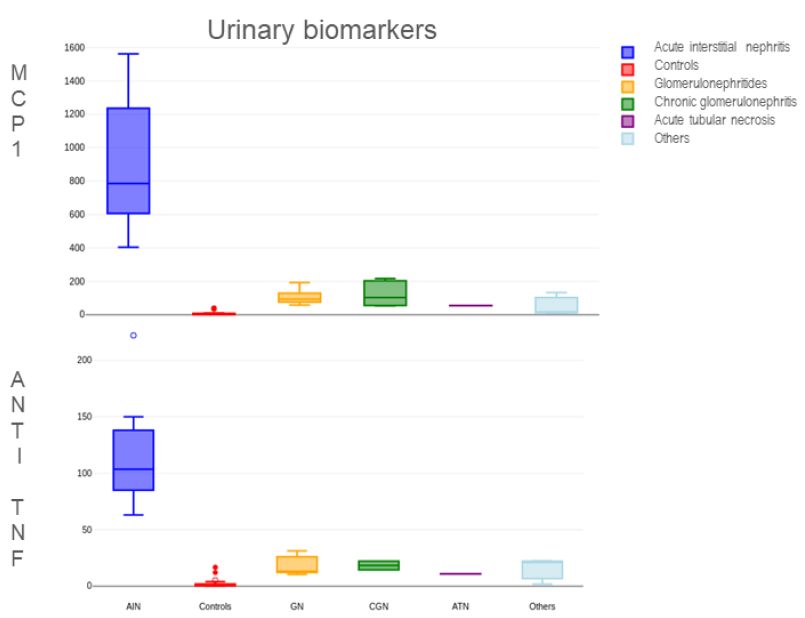Translate this page into:
Urinary Biomarkers for Non-Invasive Diagnosis of Acute Interstitial Nephritis
Corresponding author: Suryanarayana Shamanna, Department of Medicine, Jawaharlal Institute of Postgraduate Medical Education and Research (JIPMER), Puducherry - 605006, India. E-mail: sujukumi@gmail.com
-
Received: ,
Accepted: ,
How to cite this article: Palanisamy T, Basu S, Srinivas BH, Shamanna S. Urinary Biomarkers for Non-Invasive Diagnosis of Acute Interstitial Nephritis. Indian J Nephrol. 2024;34:409-10. doi: 10.25259/IJN_38_2024
Dear Editor,
Acute interstitial nephritis has been found in 5–15% of hospitalized patients with acute kidney injury (AKI).1 Kidney biopsy which is the gold standard for diagnosis2 may not be attempted in all patients, and hence, it may be useful to employ urinary biomarkers. Urinary monocyte chemoattractant protein-1 (MCP-1) and tumor necrosis factor-alpha (TNF-α) have been investigated in this regard.1 There is paucity of information from India on urinary biomarkers.
We conducted a study to identify patients with acute interstitial nephritis (AIN) among AKI patients admitted in the Department of Medicine. Here, we are reporting the biomarker results in patients who underwent kidney biopsy. Twenty-seven patients had undergone kidney biopsy and AIN had been diagnosed in ten patients. Thirteen patients had glomerular disease and four patients had ATN. Twenty-five controls in whom urinary tract infection had been ruled out by urine routine examination and culture were also tested. Urinary MCP-1 levels and TNF-α were measured by enzyme-linked immunosorbent assay (R and D systems and Abbkine, respectively). Urine MCP-1 and TNF-α levels were standardized to urinary creatinine measured in the same spot urine.
The average urinary MCP-1 was 893.6 ng/mmoL Cr and average urinary TNF-α was 116.2 ng/mmoL Cr, both well above the levels seen in other diseases and controls [Figure 1]. This validates the results from previous studies3,4 that urinary TNF-α and urinary MCP-1 levels can discriminate AIN well from the other causes of AKI in our setting.

- Box and plot diagram comparing urinary tumor necrosis factor alpha and monocyte chemoattractant protein-1 levels among various etiological subgroups and controls. AIN: Acute interstitial nephritis, GN: Glomerulonephritides, CGN: Chronic glomerulonephritis, ATN: Acute tubular necrosis, MCP: monocyte chemoattractant protein, TNF: tumor necrosis factor
In conclusion, either urinary MCP-1 or urinary TNF-α can be useful for the non-invasive diagnosis of acute interstitial nephritis.
Ethical approval
The research/study approved by the Institutional Review Board at Jawaharlal Institute of Postgraduate education and research, number JIP/IEC/2021/280, dated November 08, 2021.
Conflicts of interest
There are no conflicts of interest.
References
- Acute interstitial nephritis: Etiology, pathogenesis, diagnosis, Treatment and Prognosis. Nephrol Res Rev. 2013;5:13-20.
- [Google Scholar]
- Diagnosing acute interstitial nephritis: Considerations for clinicians. Clin Kidney J. 2019;12:808-13.
- [Google Scholar]
- Urine TNF-α and IL-9 for clinical diagnosis of acute interstitial nephritis. JCI Insight. 2019;4:e127456.
- [CrossRef] [PubMed] [PubMed Central] [Google Scholar]
- Pathological significance of a panel of urinary biomarkers in patients with drug-induced tubulointerstitial nephritis. Clin J Am Soc Nephrol. 2010;5:1954.
- [CrossRef] [PubMed] [PubMed Central] [Google Scholar]






